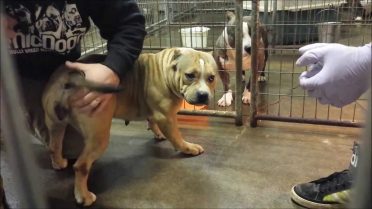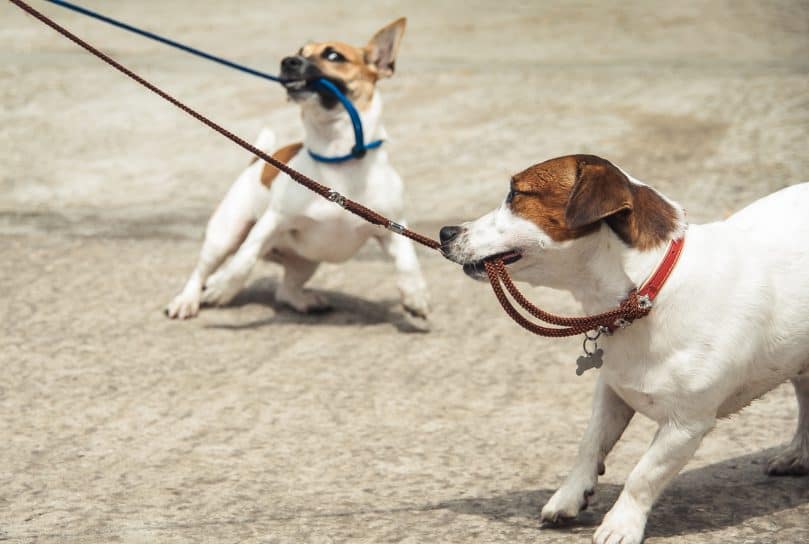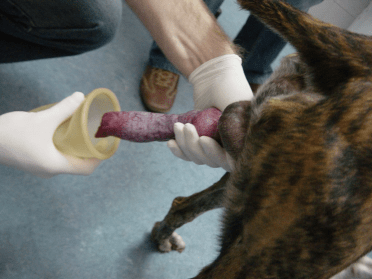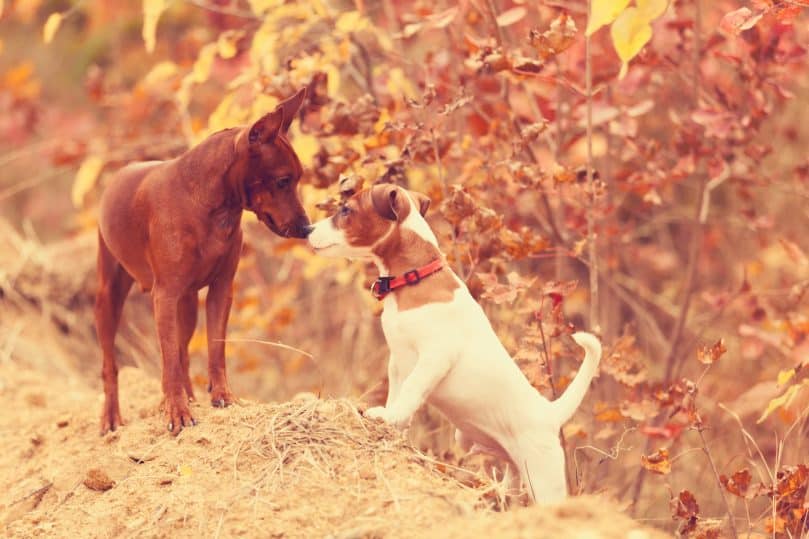This page contains affiliate links. We may earn money or products from the companies mentioned in this post through our independently chosen links, which earn us a commission. Learn More
 Artificial insemination for dogs is the deliberate introduction of semen into the cranial vagina or uterus of a bitch on her fertile time. The canine artificial insemination can be considered successful when it results in pregnancy. This insemination method provides breeders with an alternative solution for insemination in case of health issues.
Artificial insemination for dogs is the deliberate introduction of semen into the cranial vagina or uterus of a bitch on her fertile time. The canine artificial insemination can be considered successful when it results in pregnancy. This insemination method provides breeders with an alternative solution for insemination in case of health issues.
The goal of a reputable breeder is to increase conception rates while avoiding risks. All efforts are also made to produce puppies of quality and maximize the size of litters.
Let’s discuss in more detail what this type of breeding entails to help you decide if it’s a go or no-go for your dog.
Contents & Quick Navigation
What’s artificial insemination?
Also known as AI, this is a term referring to the procedure of mating canines. It’s where a stud’s semen is artificially introduced to the dam’s cervix or vagina to bring about gestation or pregnancy.
Veterinarians or experienced inseminators usually carry out this method.
But is dog AI the better option when it comes to breeding? And why do most breeders turn to artificial insemination?
AI VS Natural Breeding
Before looking for a stud service or offering your male dog to mate, you have to consider how the breeding should go.
It’s often best to let things run its natural course. Which is why it’s understandable that others would prefer breeding their pets naturally. But there are beautiful dogs out there that aren’t made of natural causes. While everything is developing around us, innovations would be included to create the most amazing breeds.

One of the most common uses of artificial insemination in dogs is crossbreeding. Mixed breeds are often a popular choice as aspiring dog owners can get the best of two canines. Aside from that, they all look so cute!
Breeds such as the Pomsky (Pomeranian and Husky mix) and the Corgi and Golden Retriever mix are some of the famous hybrids out there. And to get these adorable canines, there are a lot of things to consider, such as height differences. Reasons like this will make natural breeding difficult and unsafe.
Not only does it help fill the gap between breeds of different sizes, but it’s also beneficial when it comes to a lot of factors.
These are the common reasons why breeders, or even pet owners, choose to inseminate their dogs artificially:
Location of one or both dogs is an issue
There are breeders out there who can select and get semen from exceptional canines anywhere in the world, even those deceased champions. It is a great way to increase a breed’s quality from dogs with amazing traits such as behavior and intelligence.
Take into consideration the difference when paying for a canine to travel as well. Having the semen shipped is way cheaper and more convenient.
Besides, traveling for long periods or via an airplane can increase the risk of injuries and the stress level of your pet. If you own the male and you take him away from his typical environment, it may make him insecure or curious instead of focusing on the dam.
Genetics
It’s possible for some breeds that have low genetic diversity and a small gene pool to eventually not exist.
Choosing artificial insemination will make it possible for breeders to expand a dog’s breed diversity.
So this method of mating can improve the quality of genetics of the kennel and prevent a gene pool from diminishing to avoid any chance of extinction.
To prevent infections and sexually transmitted diseases
Since physical interaction is not needed for AI, it will keep canine STDs from harming the bitch and the stud.
Diseases such as Brucellosis may cause fatal effects on your pet such as cancer, sterility, or miscarriage. Infections that can happen during mating can be prevented. But this doesn’t mean it’s completely risk-free.
Some diseases still can get transmitted through the semen. That is why semen evaluation must be done before the actual insemination procedure.
Behavior problems
This is very common, especially for female dogs who are in heat. They’d mostly be either aggressive or extremely timid. These behavioral issues can be a factor to make breeding seem impossible.

Without the need for the two dogs to be in contact with each other physically, they won’t undergo any stress and will lead to successful insemination.
If you’re not interested in breeding the dog naturally or you’re worried because it’s your girl’s first time to mate, AI is an easy option.
Artificial insemination is also useful for old dogs who can still get pregnant or produce semen but is not fit to undergo through the breeding process. Breeders will be able to collect enough live sperm to be contained in an insemination tube.
Convenient for the owners and dogs
As the collected semen can be split and used multiple times for AI, you won’t be risking your dog from exhaustion.
Whether you’re going to use frozen or chilled semen, it will allow owners to breed their female dogs at a convenient time.
But before we go further about how this procedure is done, it’s best to know if a bitch is ready to get the inseminated. You should also be aware of how to collect semen from a dog and how it’s stored.
Semen Collection and Volume
The male dog’s arousal is vital for you to be able to collect his semen. With natural breeding, it’s easily achieved by placing a female dog in heat near him, and he’ll mount her. If a bitch is available, you have to grasp the stud’s penis before he can insert it to her vagina, then place it into a receptacle for semen collection.

With AI, if a bitch isn’t available, breeders often have a supply of cotton swabs on hand that was wiped (also known as smear) across the vaginal area of a dog in estrus. It’s stored in a refrigerator then you let the stud “catch” the scent of the female.
If you have an artificial vagina available for your dog, massage the penis to stimulate the constriction of the vagina until ejaculation happens. Once you’ve finished collecting, draw it up in a syringe.
Avoid cold shock and temperature swing of the semen until it’s properly stored and ready to use by a female dog.
Canines weighing up to a maximum of 10 pounds can generally produce one and a half to three milliliters of semen. If a dog weighs a max of 50 pounds, it’s about three to five milliliters. For those pets that go beyond 50 lbs, it’s possible to collect five to eight milliliters of sperm.
Storing semen for artificial insemination
It’s best to use the collected semen as soon as possible. If it must be stored, you can ensure its viability by refrigerating it.
Depending on the necessity of the semen, it can be stored in two ways – by chilling or freezing it.
Chilled Semen

A dog’s semen can be safely chilled up to 24 hours with only little damage to its viability. If it’s not needed during that timeframe from the moment it was collected, then it should be frozen.
Also known as fresh-chilled, this is the most common method used for insemination. Chilled semen can also be shipped. After collection, canine reproductive specialists will add special extenders, and send the sperm overnight to the trained professional who will inseminate the bitch.
Nowadays, there are some extenders that will keep the viability of semen to last up to ten days. It makes shipping chilled semen possible overseas.
It may be significantly less expensive to have chilled semen shipped, but it must coincide within the female’s heat cycle.
Freezing Semen
If the semen is going to be shipped AND be used whenever it’s convenient, then adequate freezing will guarantee the viability of it for future use.
Trained vets who specialize in canine reproduction are equipped to do this for you. They’d process, mix the semen with an extender to preserve it, and they’ll slowly freeze the sperm in liquid nitrogen.

The freezing process would allow storage and ensure fertility using a superior stud’s genes.
If the semen is going to be sent or received internationally, it’s advisable that you speak with the veterinarian who will do the procedure. They’ll inform you on what requirements are needed to get the semen to go through customs in that specific country.
There are countries who are strict when it comes to particular, time-sensitive pre-breeding blood shipment preceding to semen freezing.
An example would be places that would require rabies and some titers done at certain laboratories within given time intervals before freezing the semen.
How to tell if a female canine is in heat
If you notice that your pet’s vulva is swelling and has been bleeding (about 3 to 9 days), then her heat cycle or proestrus has started. Her uterus is also growing a new lining, preparing for the embryo.
Once the bleeding subsides, your girl will be more accepting of the male and ready to breed. The estrus or standing heat usually lasts seven days. From the third to the seventh day, it’s the only time she can get pregnant.
After the 7th day, the next stage will be metestrus, and she’d ward off her partner’s sexual advances.
So the ovulation occurs typically around the end of standing heat, which is the golden window you’d want to target if you’re going for artificial insemination. During that time, try the procedure every other day.

There are many ways of estimating the day on when to deposit semen. Since AI can’t rely on a stud dog’s nose, vaginal cytology is one way to determine if a female dog is in heat. An experienced reproductive vet can read it. This is best done every day or every other day as well.
Next is the progesterone RIA test. It’s an examination that should be done in a laboratory, where you can get the results a day after the blood is taken. It gives a precise number which gives a possibility to extrapolate good accuracy. It will also be possible to time FES (Fresh-Extended or Chilled Semen) and frozen breeding with success.
Another one is the ELISA progesterone test. It’s only about 50 percent reliable, and a great example is the frequently used “target” test.
Procedure/Methods: How to artificially inseminate a dog?
Whether you’re using fresh, fresh-chilled, or frozen semen, there are different ways that it can be administered to a bitch
But before doing so, the female dog should be in heat before receiving the sperm. It’s also possible if she’s about to or is recently ovulated. You’ll know the stage of her reproductive cycle by the results of her vaginal cytology or blood tests that show her progesterone levels.
Transvaginal insemination
It’s the least technical and most common method used when doing canine AI. For this technique, a pipette is used to deposit the semen in front of the cervix directly. The pipette’s length would depend on the size of the bitch.
The female is positioned just like in a sawhorse or show stack stance – standing with her hind legs behind her pelvis. Placing the dog this way will flatten the vaginal vault so it would be easier to insert the pipette to the cervix. Once the pipette is inserted into the dog’s vaginal vault, attach the syringe on the other end.
Avoid the urethral entrance by guiding the pipette into the top of the vagina. Do it gently while it’s traveling up, then flat, then slightly down. Then you can deposit the semen. Just fill up the syringe with air and push the remainder of the semen into the vagina.
Here’s a quick video of how to collect and handle semen, and how to inseminate it to the bitch:
Remember to keep the female in a standing position for at least ten minutes, and she shouldn’t be allowed to urinate or sit.
Some owners even confine their dog for an hour to make sure that she wouldn’t even jump. After that timeframe, you can allow the bitch to go back to her regular routine.
This should only be done using fresh or fresh-chilled semen. Even with minimal training and as long as you have the right tools, you can do the insemination on your own.
TCI or Transcervical Insemination
This is a technique that can be used with fresh, fresh-chilled, or frozen semen. It’s also a great option when breeding large or giant dogs, and if your pet can only be bred once.
To see the cervix, it can be done with palpation or using an endoscope – a unique instrument to bypass the cervix and directly deposit the semen into the uterus.
Sedation is generally not needed. Most of the time, the female dog has to stand for this method of insemination. Since a unique tool is required, a trained inseminator should administer it and for an additional cost.
Surgical Insemination

The last canine insemination technique is done by reproductive veterinarians since it requires anesthesia.
In this procedure, frozen semen is used. This is also a choice for breeding females who are older, have poor fertility, and those dogs with uterine pathology.
During the surgery, an incision is made in the abdomen to find the uterus. The vet will inject the semen either in the body of the uterine or the horn’s base.
If you’re willing to pay more for the extra equipment and trained specialists, you can opt for the insemination to be done using laparoscopy.
The success rate of artificial insemination in dogs
AI has been used successfully in breeding different animals such as cattle.
For canine breeding, you can achieve the best success rate when using fresh semen. Other factors that can affect how successful the procedure is the skill of the person administering the insemination and the type of semen used.
When using chilled semen, the success rate can drop to a range of 59 to 80 percent.
TCI and Surgical Insemination can reach conception success rates of 80 to 100% if the estrus cycle is managed appropriately.
However, this type of mating or breeding often produces smaller litters. Breeders consider this as a justifiable compromise with the advantages offered by AI. With this technique being widely used, the technology for artificial insemination is getting better, which means success rates will also improve.
Recovery from canine artificial insemination

With the first two methods for AI, female dogs are fully conscious, and there’s no need for recovery.
Aside from ensuring that she doesn’t sit, pee, squat, or jump after the procedure to make sure the semen stays in the uterus, they’ll be fine.
Aside from requiring sedation, endoscopic placement of tubes to insert the semen is a bit more invasive.
If anesthesia is used, the female will recover and get discharged on that same day. If your dog has gone under surgery, avoid complications by keeping her confined in a crate placed in a quiet space for up to 10 or 14 days.
What to consider before choosing artificial insemination for dogs
It’s understandable that methods that offer convenience can quickly become popular, but all things come with a disadvantage. As a breeder and owner, we should be concerned about how dog AI overlooks the process of natural mating.
Choosing canine artificial insemination right away can conceal the fact that either the dog or the bitch is aggressive. It can also mean that a dog will never know how to breed naturally.
The loss of physical contact doesn’t necessarily mean that cross-infection is eliminated. Illnesses such as brucellosis can still be passed on through the semen. But obviously, any risk that may come from females is eliminated.
Responsible breeding entails that dogs selecting for mating should have exceptional conformation, character, and would produce better generations. So the welfare and benefits to the bitch should always be a top priority before going through this procedure.
You’d also have to think about meeting specific conditions if you want to register the litter produced using AI.
The American Kennel Club have application forms available for you to register puppies that came from artificial insemination using fresh, chilled, and frozen semen.
Always have a copy of your dog’s registration and DNA certificate before, during, and after breeding. Some vet hospitals can microchip your pet at the time of the collection and freezing if needed.
How much does artificial insemination for dogs cost?
The cost of a vial or straw of semen would vary in price. It will all depend on the male dog’s pedigree and heritage.
Normally, the stud fee for natural breeding would be around $500 to $1,000.
Expect to pay more especially if you would have to think about how much it would cost to order semen from a top of the line stud nationally or internationally.
Reproductive services for dog AI
Specialists or veterinarians who focus on utilizing the latest procedures and techniques for canine breeding are available everywhere. In fact, they are recognized by breeders and vets.
Even if you know someone who can do it at your home, others offer complete services at clinics or animal hospitals. It can range from pre-breeding examinations to high-risk situations like a planned cesarean.
Here are some websites you can check out that offers dog artificial insemination services:
- Olney-Sandy Spring Veterinary Hospital (Maryland)
- Midwest Animal Hospital (Illinois)
- Smith Veterinary Hospital (Minnesota)
- Deason Animal Hospital (Texas)
- Skipworth Veterinary Clinic (Kentucky)
Prevention: When is canine artificial insemination unnecessary?
If there’s a good genetic diversity, even between unrelated breeds, and the stud or female is within easy traveling distance, then there’s really no need to go for AI.
It’s also unnecessary to opt for artificial insemination if the breeding is planned within the golden window – the female in heat and about to ovulate.
There are female canines who are labeled as “poor breeders,” saying that they aren’t in full heat to forcibly restrain them from natural breeding.
Other reasons not to AI includes when a bitch is unattractive for a male due to incorrect timing and odor from a severe vaginal infection. If infections are apparent, reconsider all kinds of mating.
If you’re planning to do artificial insemination for your dog at home with a homemade AI kit or DIY tools, there’s a downside to it as well. There are some bitches with vaginal lacerations caused by inexpert attempts to try this type of breeding. To avoid such risks, have a qualified vet give insights at how it’s correctly performed.

Always think of the dog’s well-being first
The bottom line when breeding dogs is putting the welfare of the canines involved and thinking of their future generations.
Practice care and proper cycle management to ensure relatively acceptable conception rates and litter sizes. If it’s not performed at the right time, then fertility rates will suffer.
Don’t try anything on your beloved pet just because it’s accessible and a lot of people you know has been doing it. Weigh in the advantages and disadvantages of AI and if it’s the only option you have.
What’s your opinion on dog artificial insemination? Tell us your side by typing it all in the comment box below.

Leave a Reply